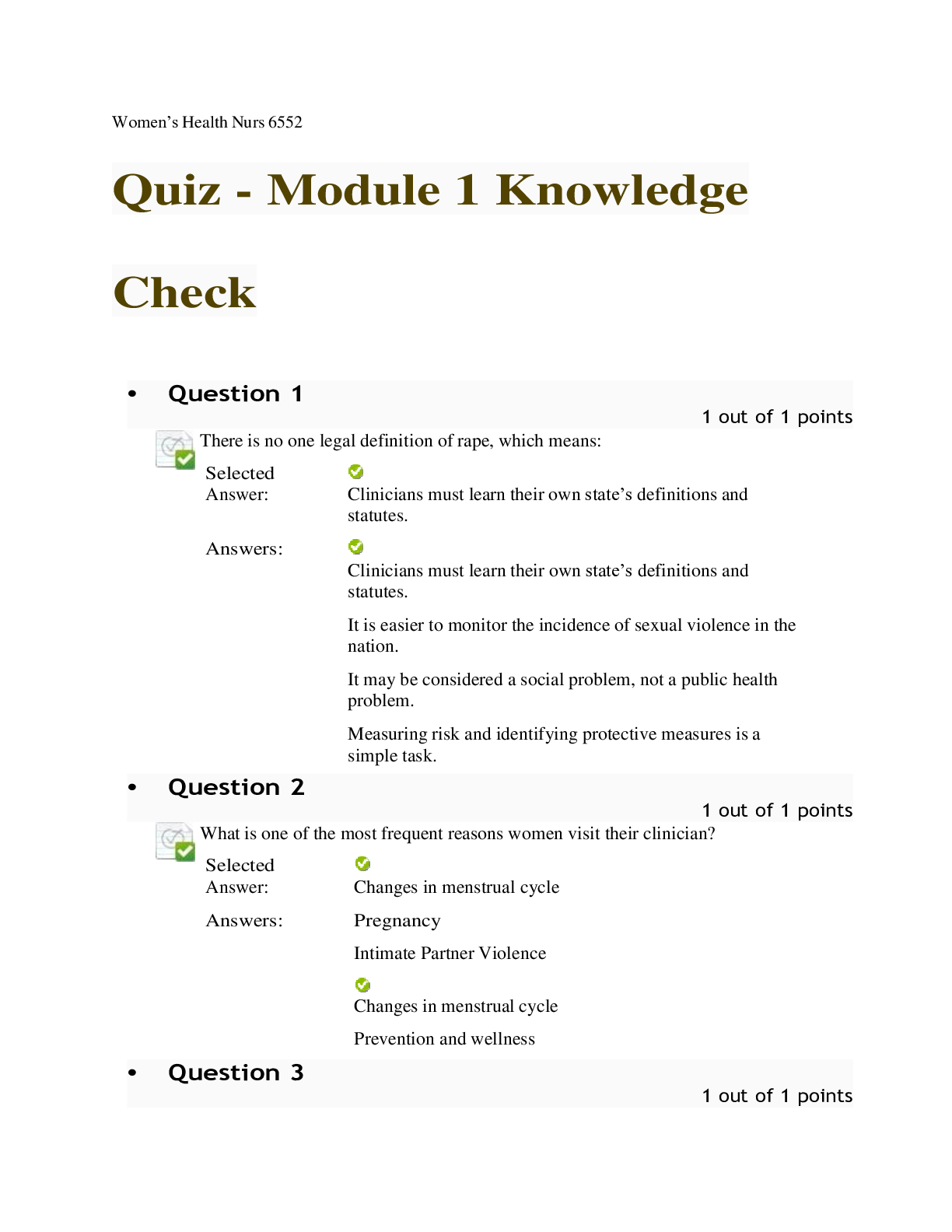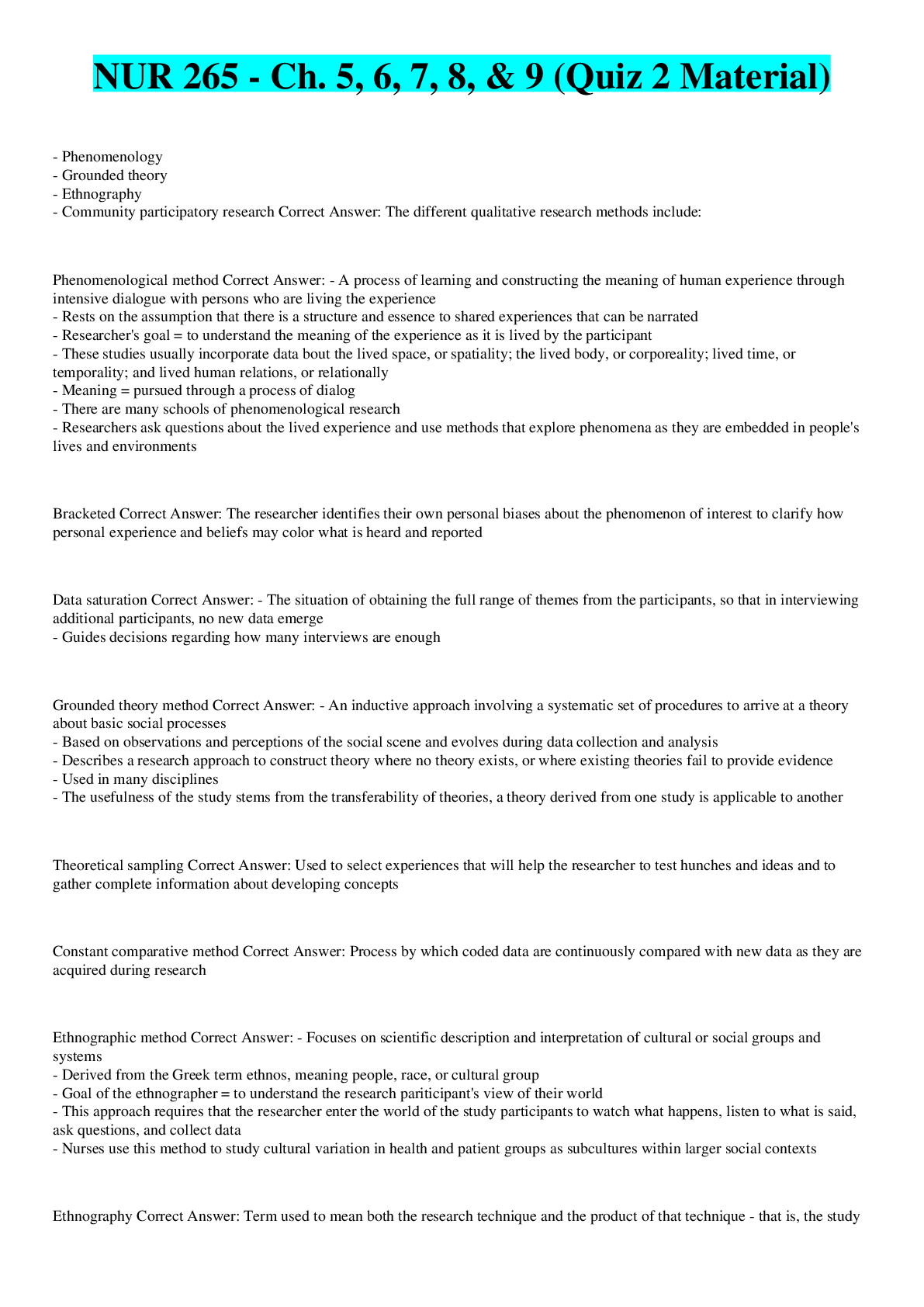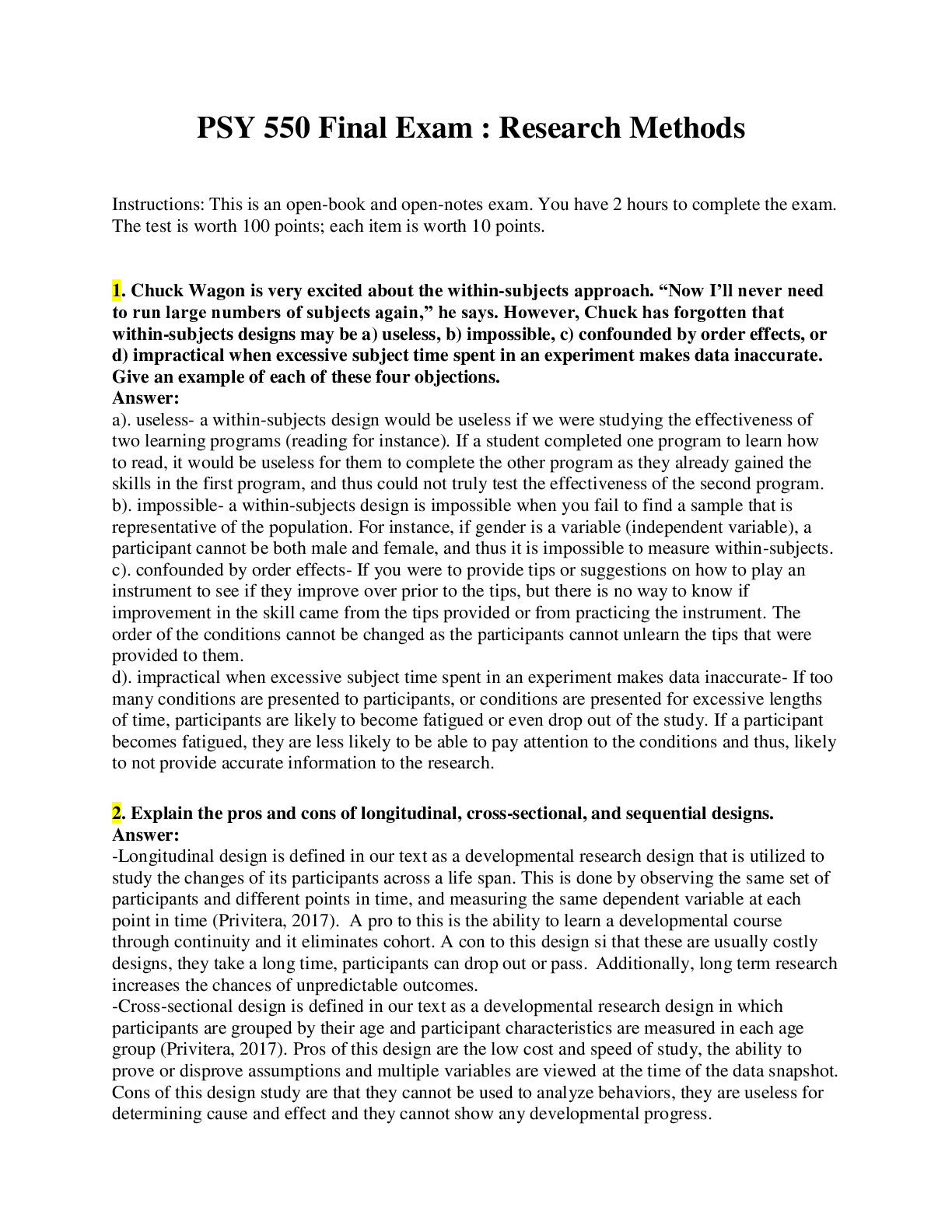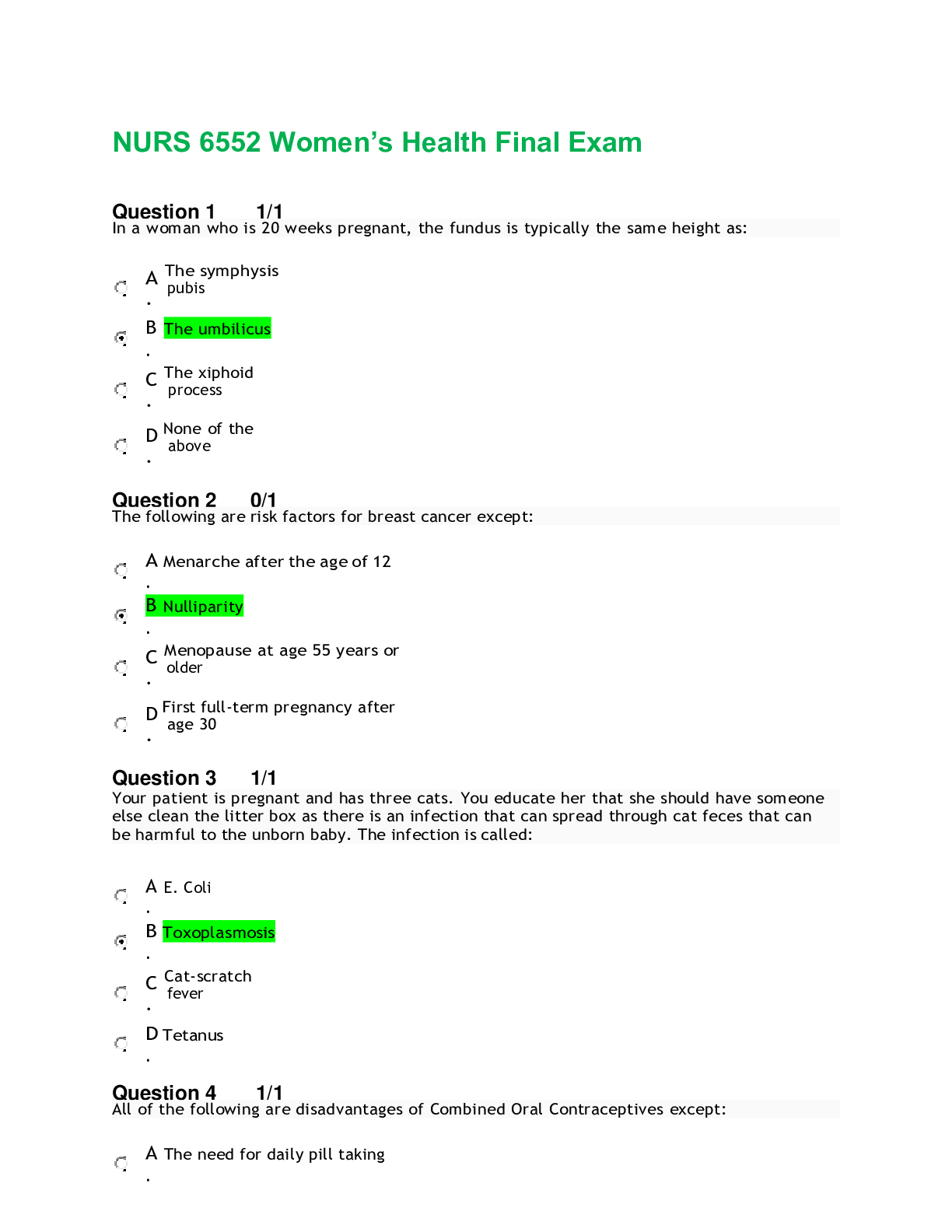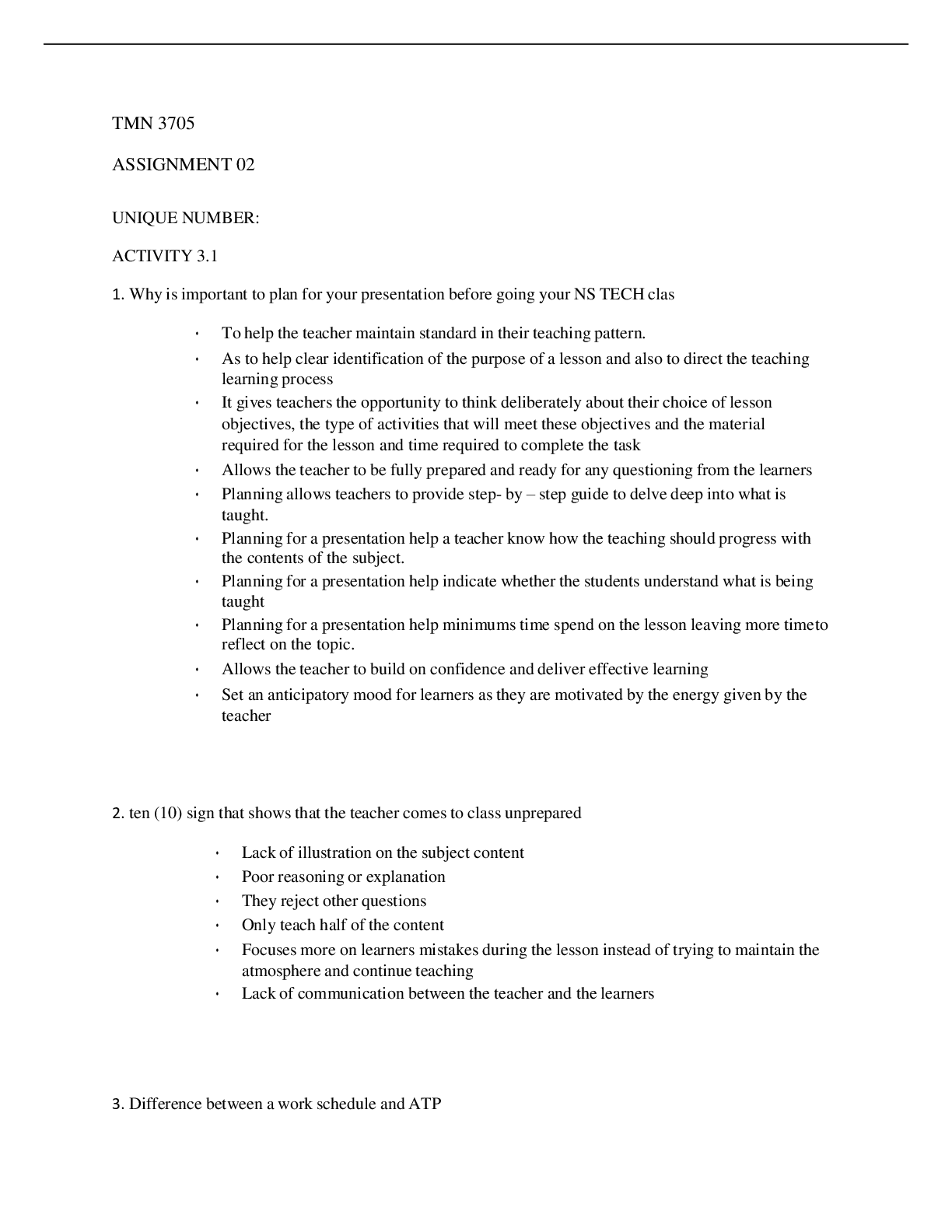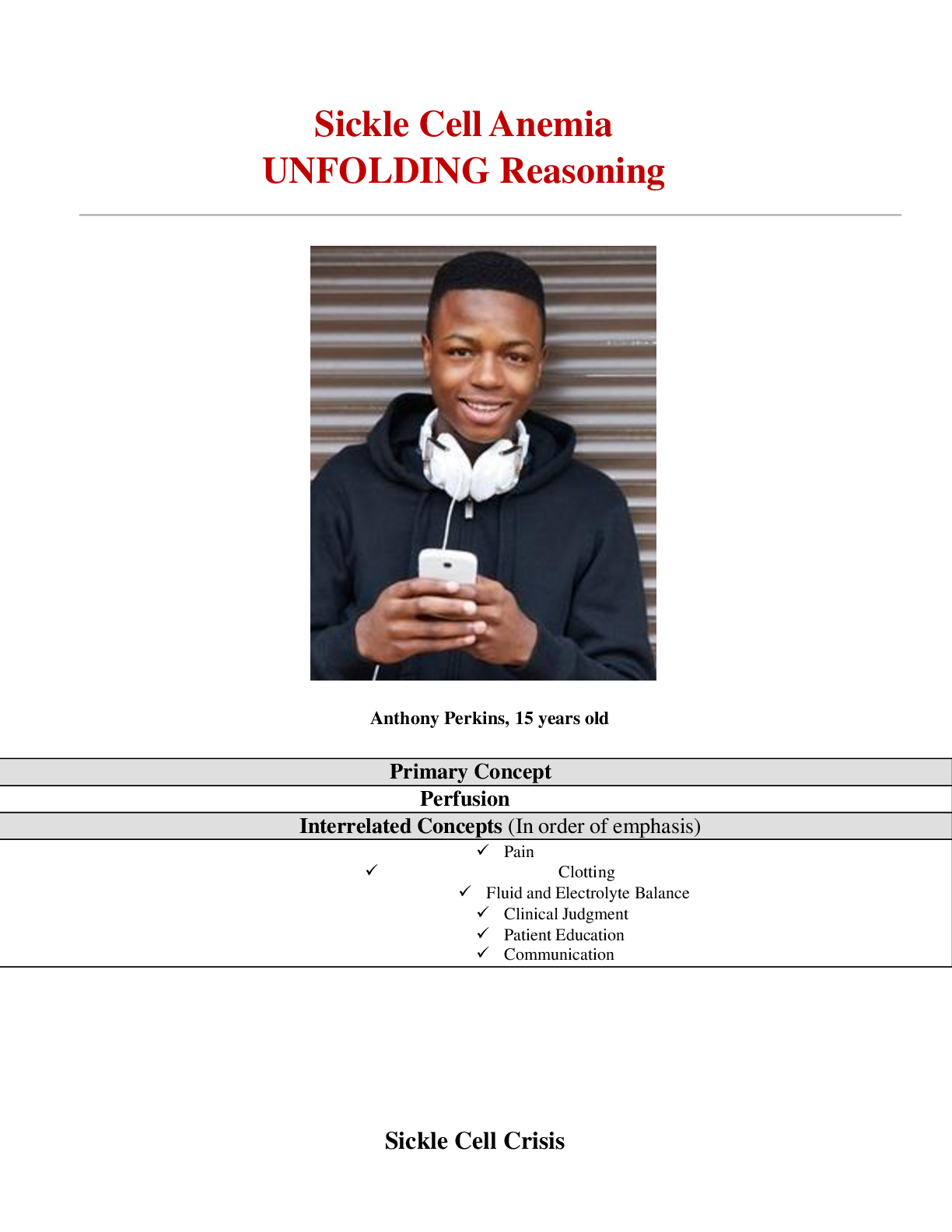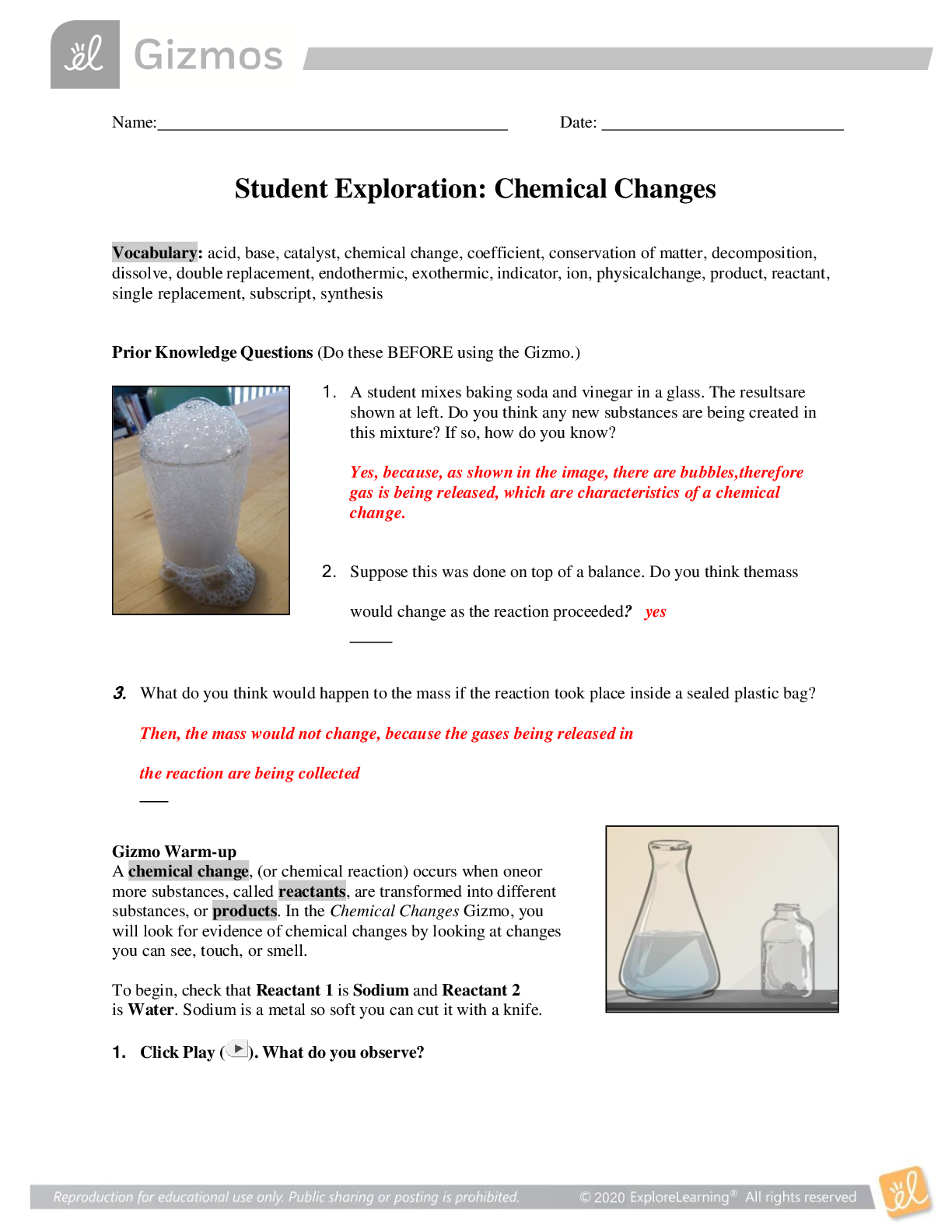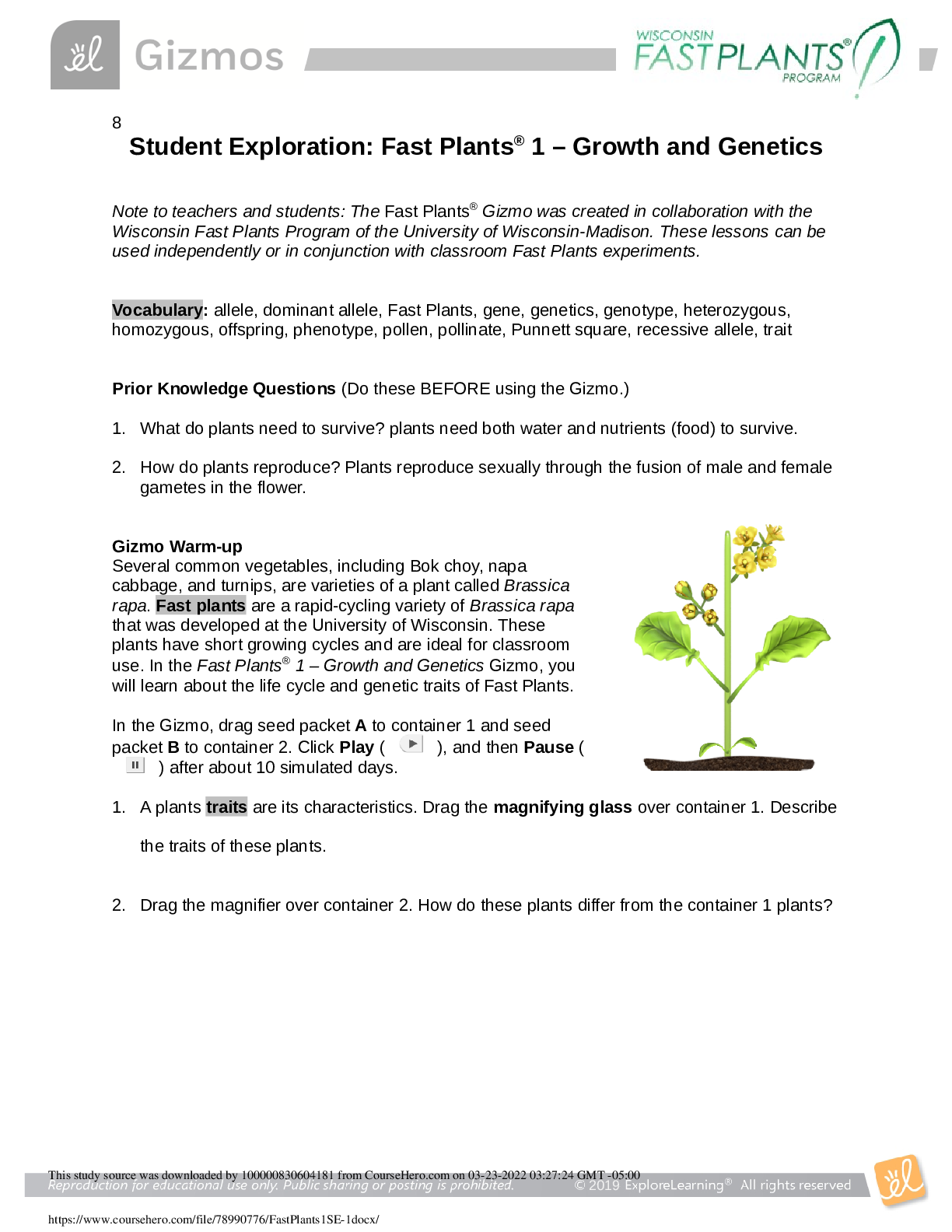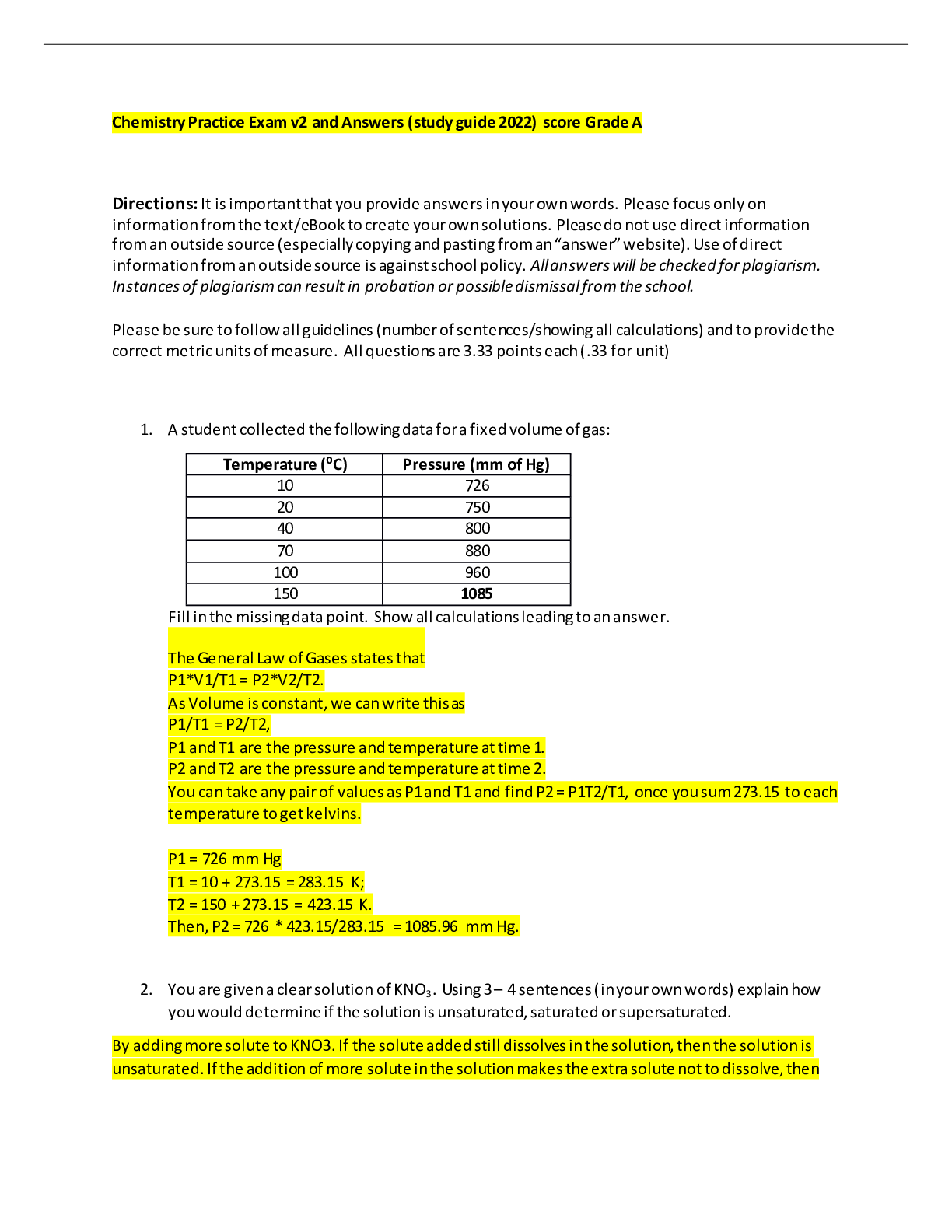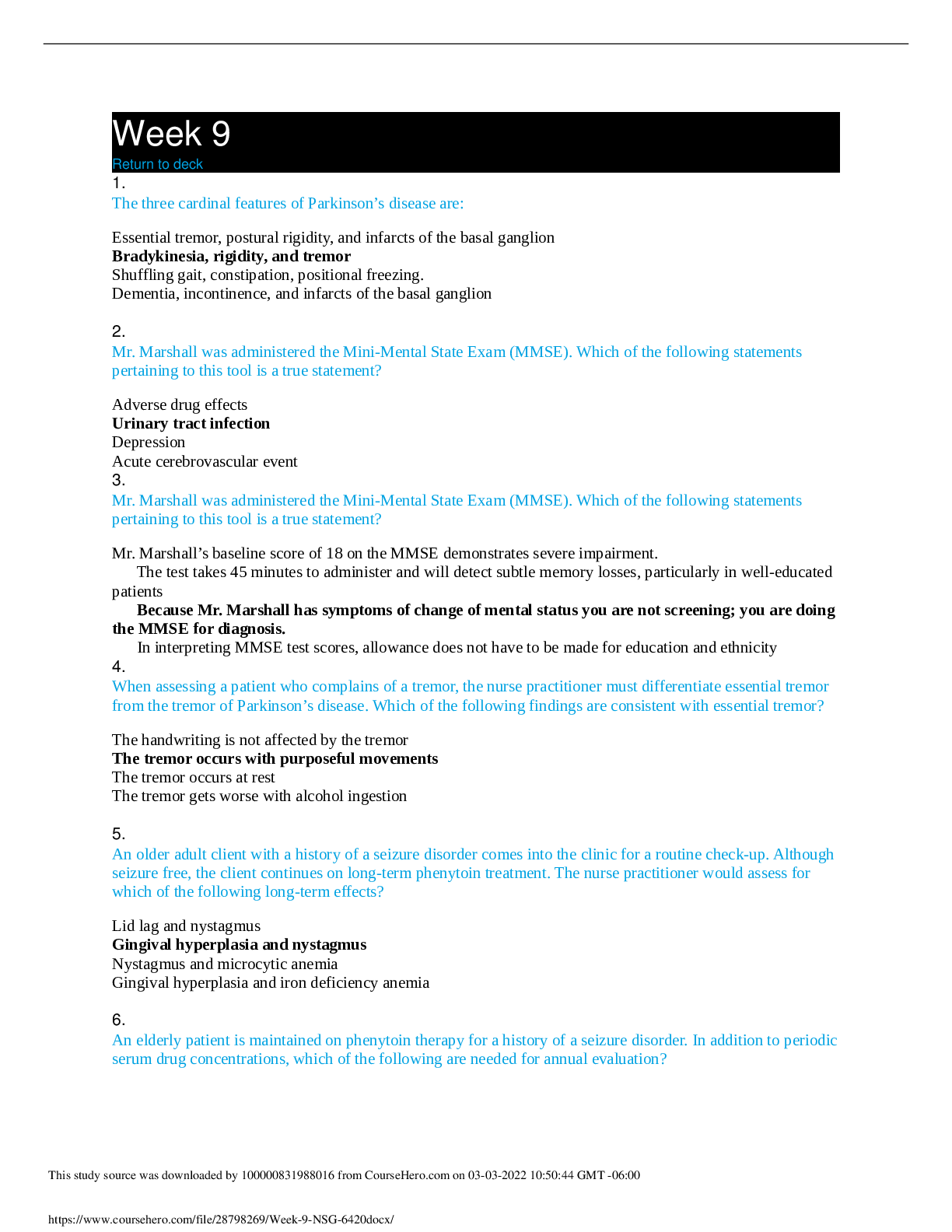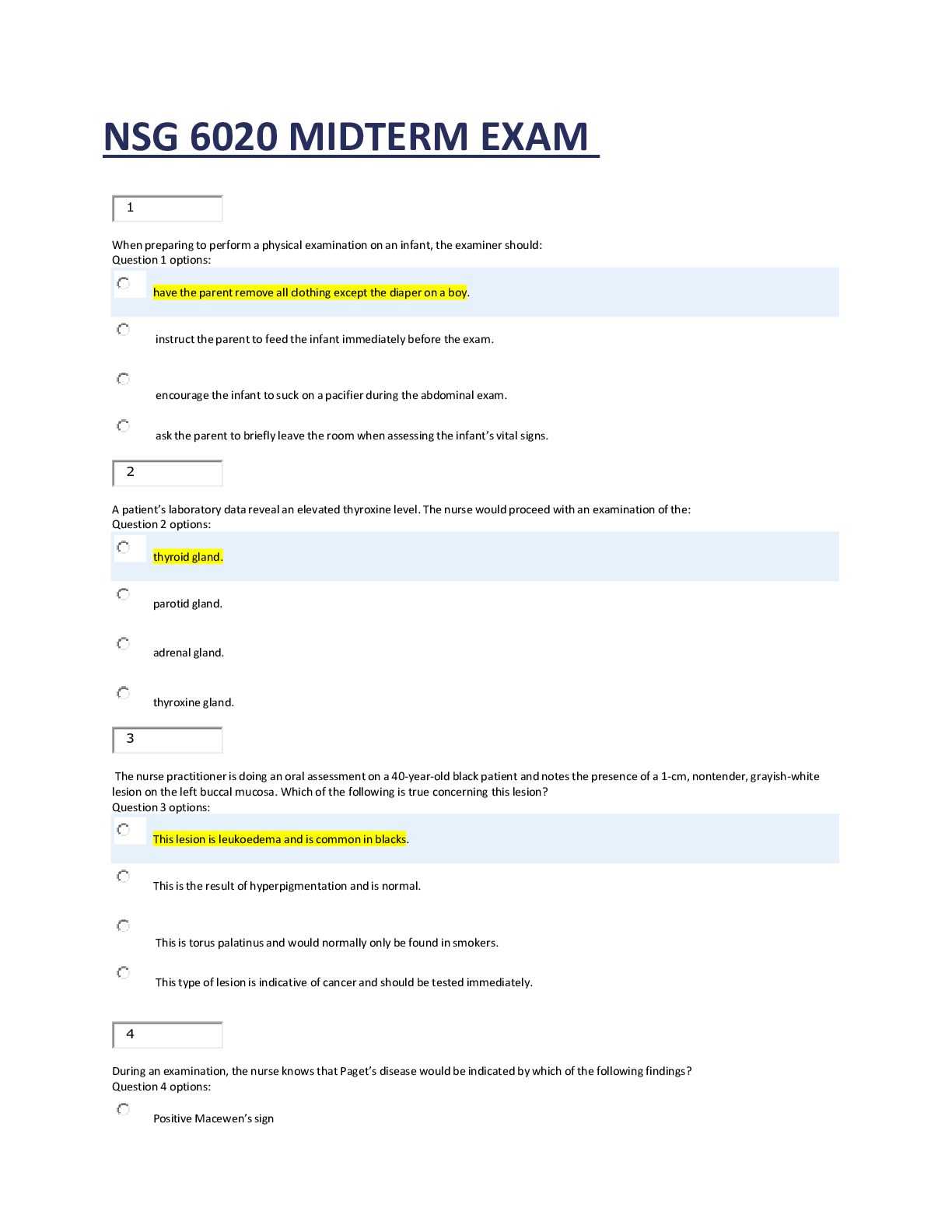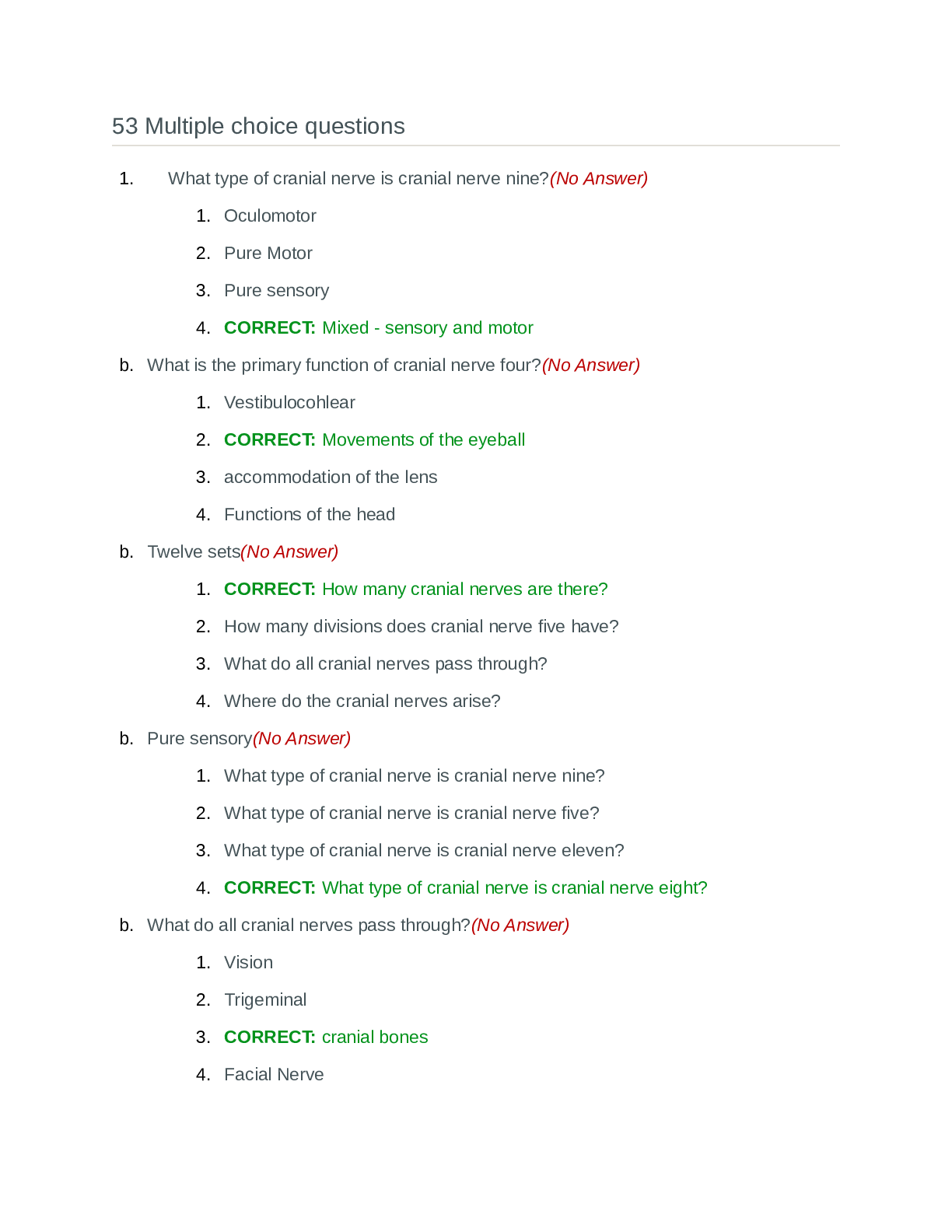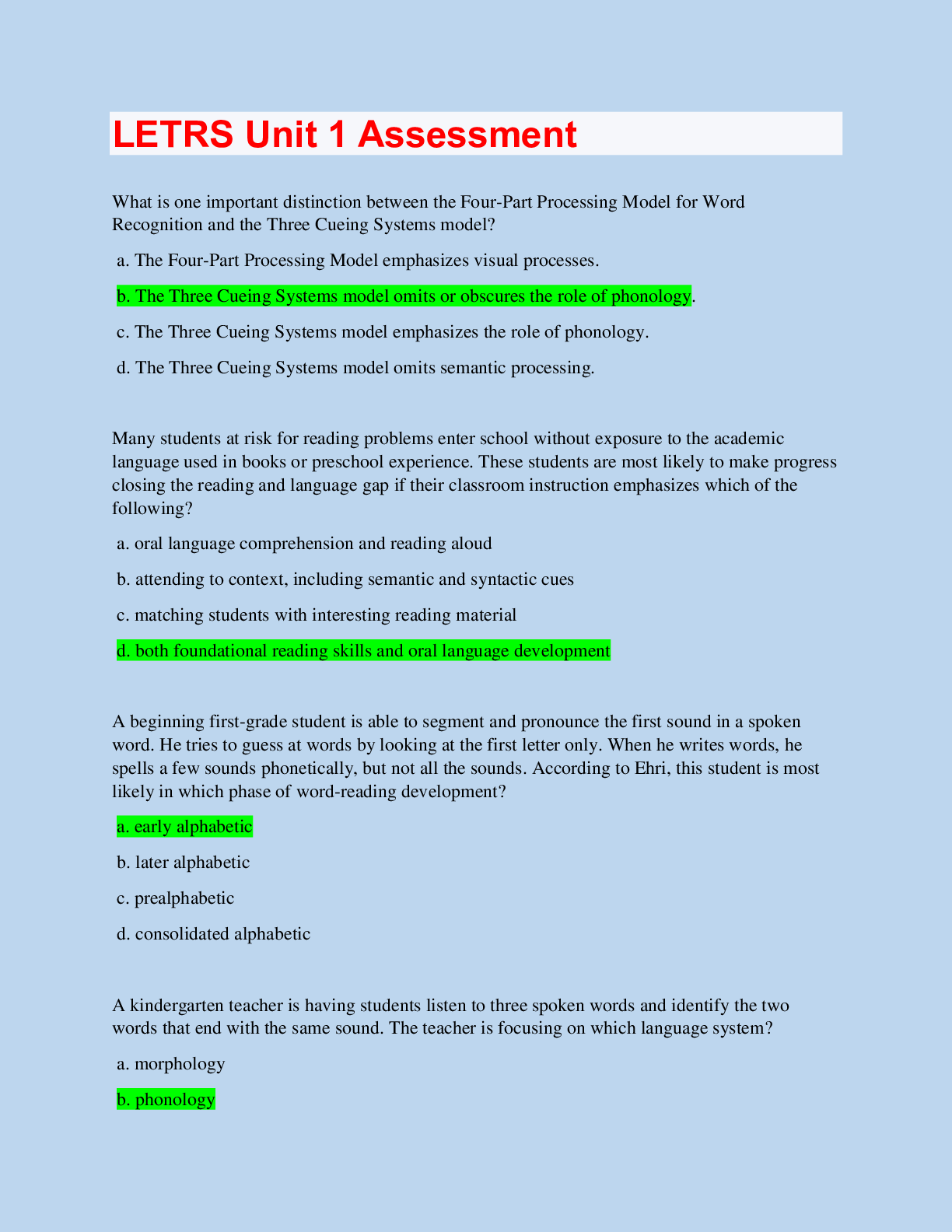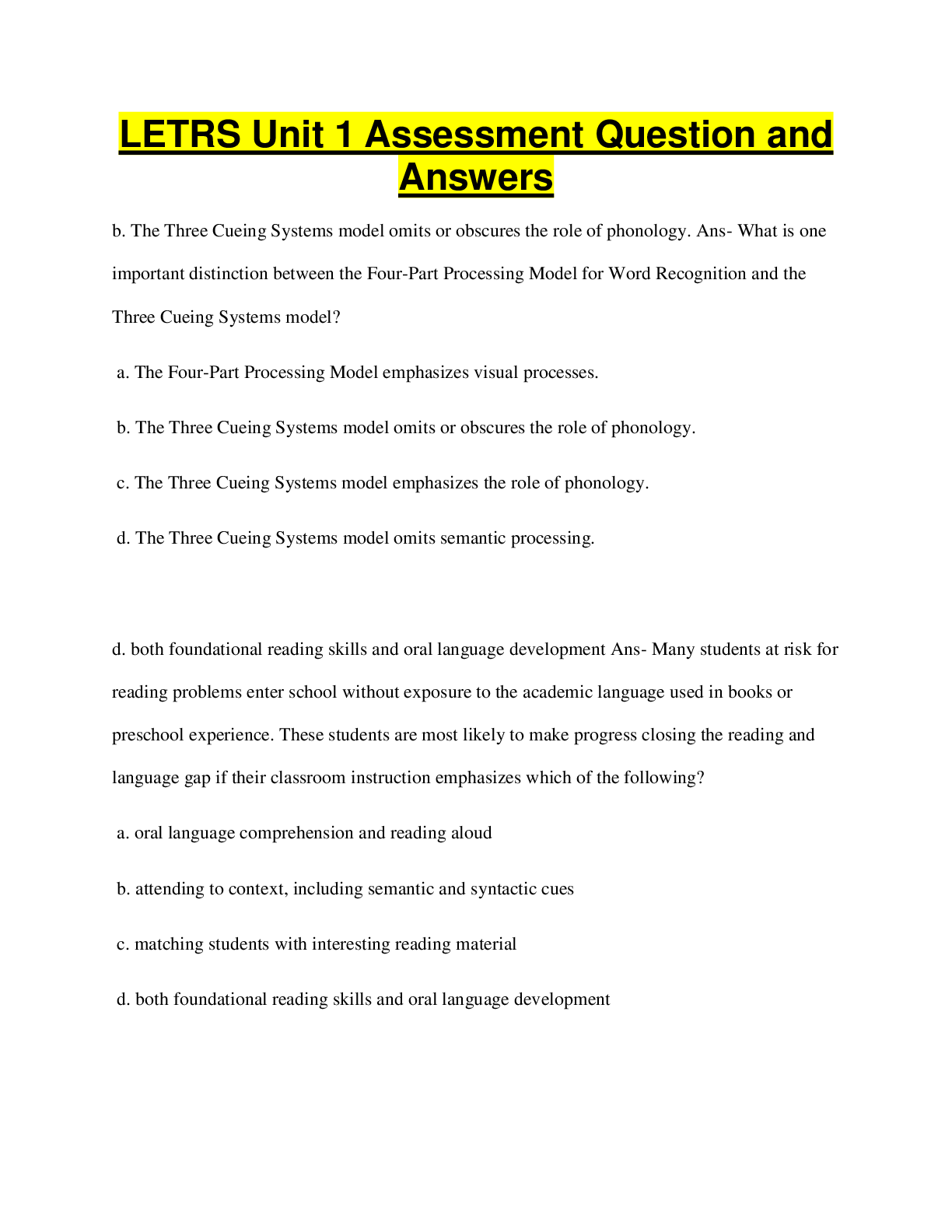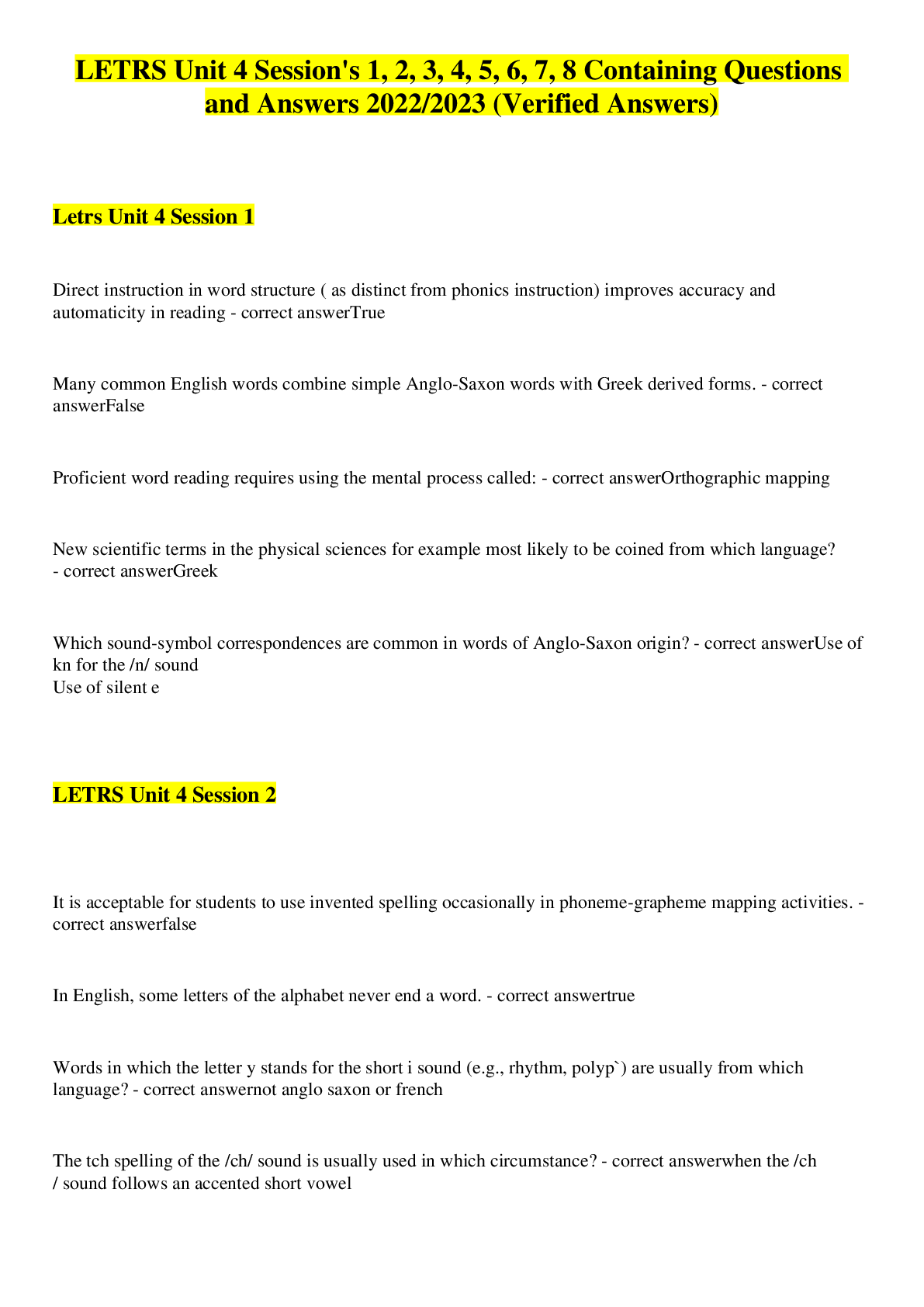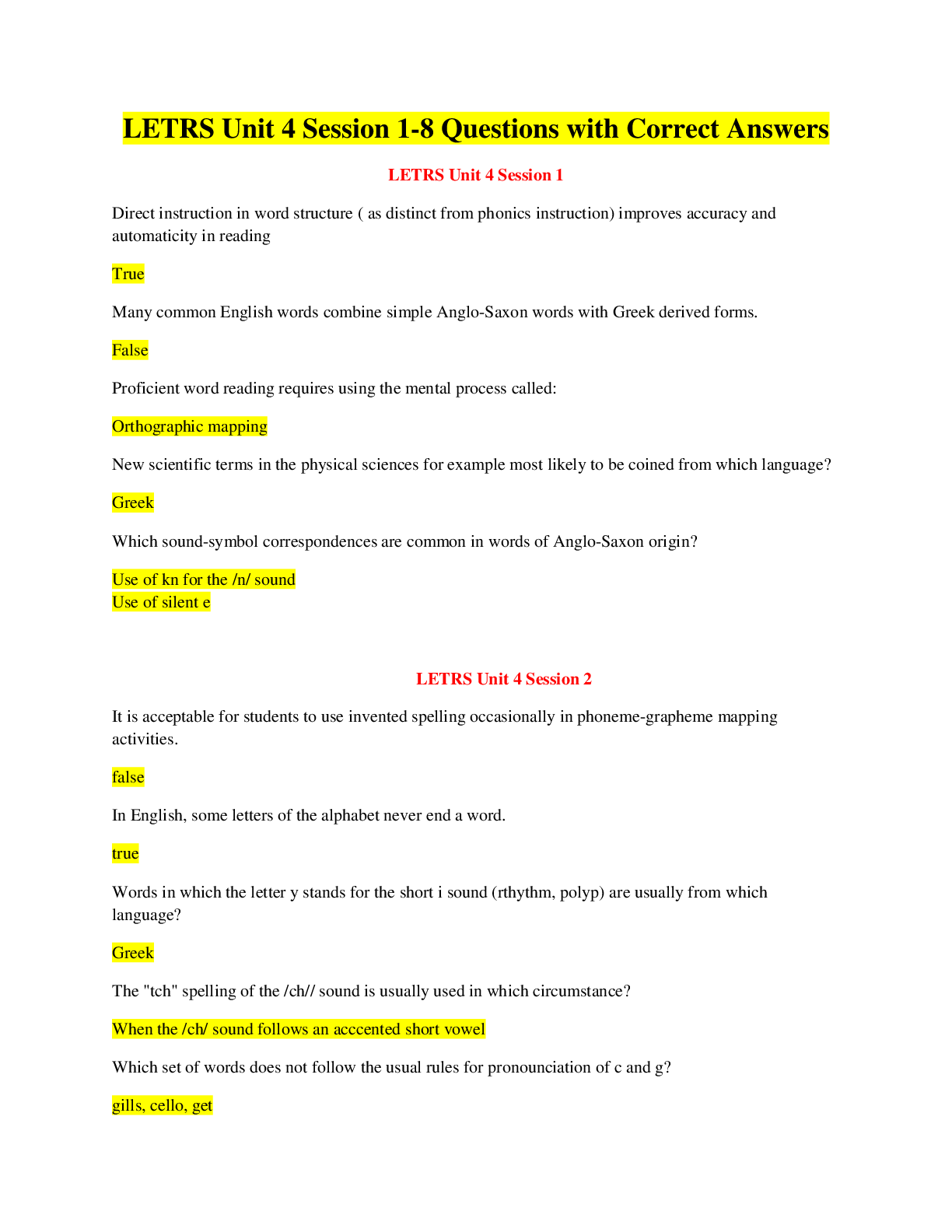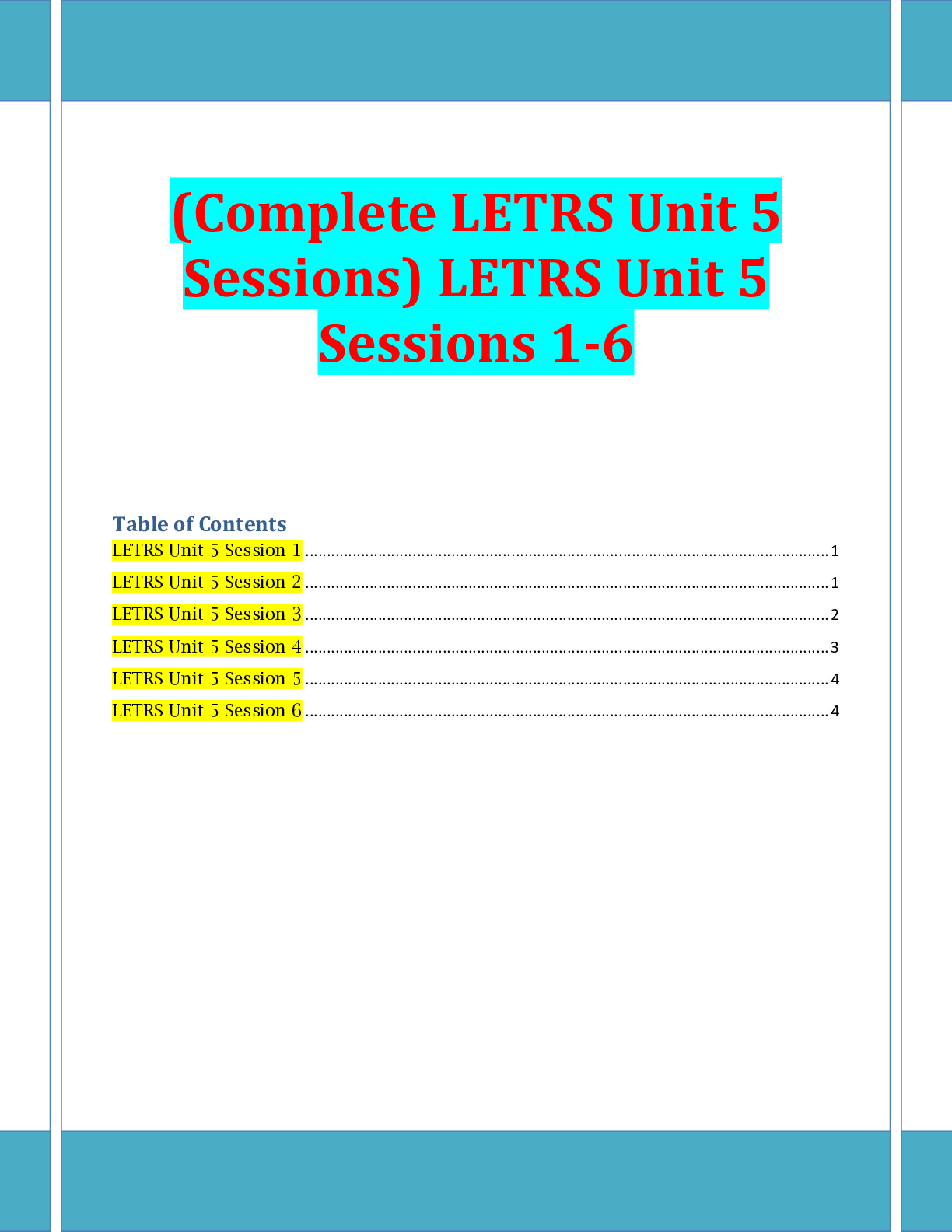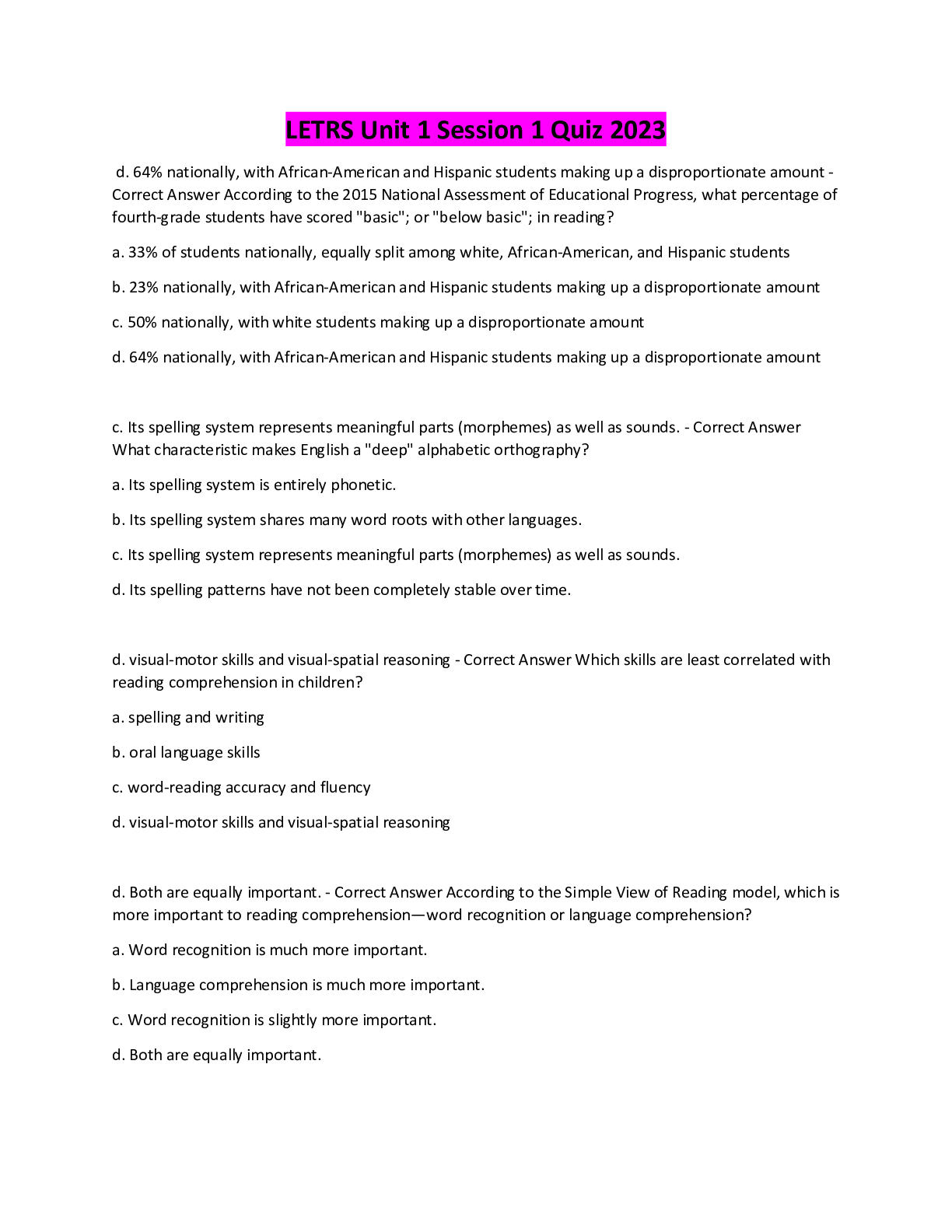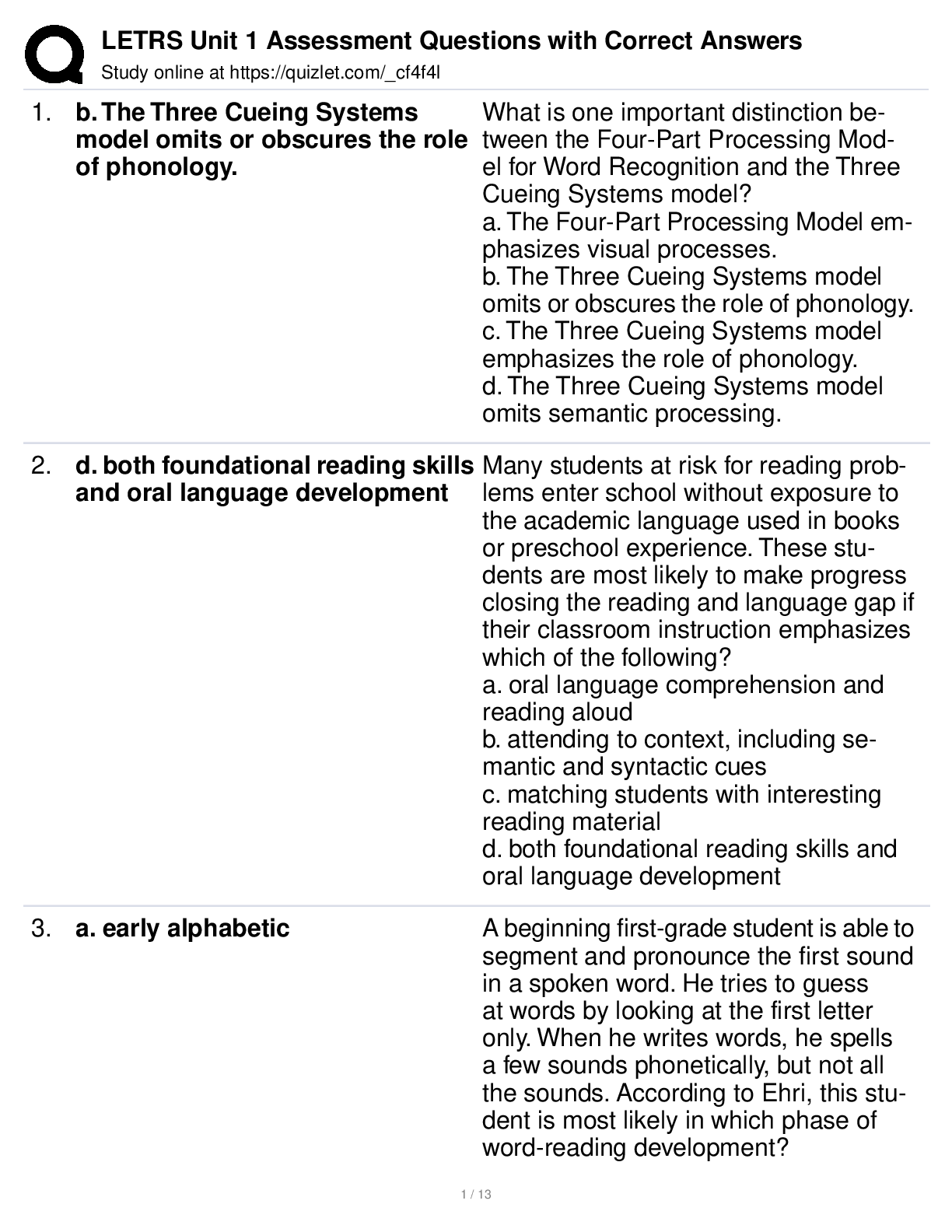*NURSING > EXAM > HESI A2 CHEMISTRY FILES Revision Questions with top Rated Answers and Updated Material to Score Grad (All)
HESI A2 CHEMISTRY FILES Revision Questions with top Rated Answers and Updated Material to Score Grade A 2021
Document Content and Description Below
HESI A2 CHEMISTRY FILES Revision Question with top Rated Answers 2021 | What are all metric measurements composed of? What is the most commonly used temperature scale in the scientific community? ... The nucleus of an atom contains or is made up of which of the following? What is an atom that has a positive charge called? In the periodic table, what are the rows called? What is the atomic number? Which of the following describes the atomic mass? Chemical equations are written in which manner? What is the charge on potassium in the compound KCl? A catalyst is a substance that accelerates a reaction by which of the following? Percent concentration of a solution is expressed as which of the following? What will one liter of a molar solution of any element contain? Chemical bonding is the bonding of which of the following? Which of the following describes an ionic bond? What is the concentrationof 58.5 g of NaCl in 2 L of solution (atomic weights of each elements are as follows: Na=23g/mol, Cl=35.5g/mol)? 0.5 mol NaCl In a redox reaction, which of the following describes reduction? It is the gain of electrons What are acids? What is a benefit of water's ability to make hydrogen bonds? What are bases or alkaline solutions? Chemical reactions in living systems proceed along catabolic pathways, and there tends to be an increase in which of the following? Entropy What is a pH of 7? Neutral Which is the correct way to write Iodine (I) with an atomic mass of 131? What is the correct formula for magnesium chloride? What is the weakest of all intermolecular forces? Which of the following describes carbohydrates? Glycolysis is one of the body's chemical pathways for which of the following? Amino acids are the building blocks for which of the following? What is the union of two amino acids using a peptide bond Subatomic particles consist of: d. Isotopes e. Ions f. Protons, Neutrons, and Electrons g. Elements The correct answer is C. The subatomic units are what give atoms their properties and consist of protons, neutrons, and electrons. 2. Which of the following is true of elements? e. They are substances made of 100% of the same type of atom f. When neutral, they are substances in which the number of protons and electrons are identical g. The positively charged protons and negatively charged electrons are responsible for the attraction of atoms within an element h. All of the above are true 3. Which groups of elements on the periodic table are considered main group elements? e. Groups 1, 2, 13, 14, 15, 16, 17, and 18 f. Groups 1, 2, 14, 15. 16, 17, and 18 g. Groups 13-18 h. Groups 1-2 4. What are transition metals? e. Elements that serve as a transition between group 1 and 2 elements. f. Elements that serve as a transition between the two main group elements g. Elements that serve as a transition between lanthanides and actinides h. Elements that have electrons which do not transition between orbitals 5. In which order do electrons fill orbitals? e. 1, 2, 3, 4 f. a, b, c, d g. 2, 2, 6, 6 h. s, p, d, f 6. Which of the following is the correct electron configuration of Chlorine? e. 1?22?22?63?2 f. 1?22?22?63?23?5 g. 1?22?22?63?23?6 h. 1?22?22?63?23?64?2 The correct answer is B. Coefficients 1, 2, 2, 3, and 3 are energy levels of Cl. As you can see "p" sub shell can have maximum 6 electrons. Superscripts 2, 2, 6, 2 and 5 are electrons in the sub shells "s" and "p". 7. What applications does molecular weight have in chemistry? e. It is used to determine how many grams are in one mole of a substance f. It is used to determine an element’s state of matter g. It is used to determine electron configuration h. It is used to determine entropy 8. Determine the molecular weight of the caffeine molecule with formula C8H10N4O2 e. 182.1906 g/mol f. 170.1906 g/mol g. 194.1906 g/mol h. 206.1906 g/mol 9. Determine the molar mass of table salt NaCl e. 58.44 g/mol f. 81.43 g/mol g. 58.44 amu h. 81.43 amu 10. Convert 25g KMnO4 to moles e. .929 mole f. 2.73 mole g. .158 mole h. .169 mole 11. Of the below, which element is most electronegative? e. K f. Fe g. Cl h. Ne 12. What characteristic is true for polar substances? e. Polar substances have low freezing points f. Polar substances have uneven electron distribution g. Polar substances are composed of transition metals h. Polar substances have a high affinity for non polar substances 13. Which of the following properties of water is due to hydrogen bonds within the molecule? e. Strong surface tension f. High specific heat g. High heat of vaporization h. All of the above 14. Which of the following characteristic are true of conjugate acids and bases? e. They gain and lose electrons equally f. They gain and lose protons equally g. They gain and lose neutrons equally h. None of the above 15. Which of the below is true of conjugate pairs? e. They may either be “base + conjugate acid” or “acid + conjugate base” f. They may either be “acid + base” or “conjugate acid + conjugate base” g. If one member of the pair is very strong, the conjugate member of the pair is usually weak h. More than one of the above are true The correct answer is D. Both A & C are true statements. Conjugate pairs comprised of one reactant and one conjugate of the opposite pH classification (acid or base). Another helpful checkpoint in determining conjugate pairs is to look at strength. If an acid reactant is very strong, its conjugate base counterpart will likely be weak. The reverse is true as well. 16. How are conjugate pairs identified? e. The conjugate acid to the reactant base will have lost a hydrogen ion f. The conjugate acid to the reactant base will have gained a hydrogen ion g. The conjugate base to the reactant acid will have gained a hydrogen ion h. All of the above are true The correct answer is B. For a base + conjugate acid pair, the conjugate acid will have gained a hydrogen ion with respect to the base reactant. 17. How are redox reactions classified? e. Redox reactions involve the transfer of elections and change of oxidation numbers f. Redox reactions involve the transfer of hydrogen ions and change of oxidation numbers g. Redox reactions involve the translocation of conjugate pairs h. None of the above 18. The rules for determining oxidation number are many and complex. Below is a list of the rules – some of which are TRUE and some of which are FALSE. 10. Free elements always have an oxidation number of 0. 11. Monoatomic ions always have oxidation numbers equal to the charge of the ion. 12. Hydrogen’s oxidation number is +1 unless it is combined with less electronegative elements, in which case the oxidation number of H is -1. 13. In compounds, oxygen has an oxidation number of -2, with the exception being that it is - 1 when in peroxides. 14. Group 1 elements have an oxidation number of 0 15. Group 2 elements have an oxidation number of +1 16. Group 17 elements in binary compounds have an oxidation number of -1 17. The sum of oxidation numbers of all of the atoms in a neutral compound must equal 0. 18. The sum of oxidation numbers in a polyatomic ion must equal to the charge of the ion. Which are FALSE? e. 2 and 7 f. 2 and 5 g. 5 and 6 h. 6 and 9 19. Which of the below are redox reactions? e. 2Fe2O3(s)+3C(s)→4Fe(s)+3CO2(g) f. NaCl+AgNO3⟶AgCl +NaNO3 g. 3C2H2⟶C6H6 h. HCl+H2O⟶Cl−+H3O+ 20. Assign oxidation numbers to each element of this compound: Na2SO4 e. Na=+1, S=+1, O=-2 f. Na=+2, S=-2, O=0 g. Na=0, S=0, O=+2 h. Na=+1, S=+6, O=-2 21. The combined gas law: e. Is a combination of Boyle’s law, Charles’s law, and Avogadro’s Law f. Is represented by ?1?1?2 = ?2?2?1 g. Neither are true h. Both are true 22. A gas has a volume of 23L at 200K and 12 atm. What would the volume of the gas be at 300K and 14 atm? e. 20L f. 29.6 L g. 30.2 L h. Unable to determine with the information given 23. The ideal gas law e. Is used to predict the behavior of gas under many conditions f. Has the formula PV=nRT g. Uses Avogadro’s constant of 6.02214086 × 1023 mol-1 h. All of the above are true 24. What is the pressure exerted by 4 moles of nitrogen gas contained in a 30 L container at 298K? e. 39, 736 atm f. 2.3927973e+25 atm g. 3.26 atm h. None of the above 25. Specific heat e. Is the amount of energy required for a substance to boil f. Is twice the sum of the energy of the chemical bonds within a molecule g. Is generally higher in lanthanides than actinides h. Is the amount of energy required to raise 1 gram of substance by 1 degree Celsius 26. The temperature of an unidentified metal with a mass of 63.4g increased from 25C to 48C as the metal absorbed 849J of heat. What is the specific heat of this metal? e. .45 J/gC f. .55 J/gC g. .65 J/gC h. .75 J/gC 1. What are the reactants? a. CH4 and O2 b. CO2 and H2O c. Both d. None of the Above 2. What are the products? a. CH4 and O2 b. CO2 and H2O c. Both d. None of the Above 3. How many hydrogen atoms are present in the reactants? a. 2 b. 4 c. 1 d. None of the above 4. How many oxygen atoms are in 2O2? a. 2 b. 4 c. 1 d. 0 5. How many water molecules are present in the products? a. 2 b. 4 c. 1 d. 0 6. Which of the following is most true? a. 2H2O has 2 hydrogen atoms total b. 2 H2O is two water molecules c. H2O2 is two water molecules d. None of the above 7. Which of the following is most dense? a. A block of gold that is 12g and 4.6cm³ b. A cube that is 6g and 0.91cm³ c. A block that is 143g and 24.3cm³ d. None of the above 8. Solids will always sink in liquids. a. True, a solid is hard and liquids are not b. True, solids are heavier than liquids c. False, solids have a smooth surface so they will float d. False, it depends on the density of the solid and liquid 9. Which of the following has the most molecular interactions? a. Solid b. Liquid c. Gas d. None of the above 10. Which of the following has the most molecular motions? a. Solid b. Liquid c. Gas d. None of the above 11. Which of the following is most commonly present at very high temperatures? a. Solid b. Liquid c. Gas d. None of the above 12. Which of the following is false about dissociation? a. It is reversible b. Ions are not present c. It involves molecules separating d. All are true statements. 13. What is present in an emulsion? a. Water and salt b. Two or more immiscible liquids c. Any liquids d. All are present in emulsion. 14. What is pH? a. The measure of concentration of H+ and OH- b. The measure of concentration of hydrogen c. The measure of concentration of H2O d. None of the above 15. Which of the following is the general reaction for neutralizing acids and bases? a. Acid + water → base + salt b. Base + water → acid + salt c. Salt + water → acid + base d. Acid + base → water + salt 16. Which of the following is not an organic compound? a. H2O b. C2H6 c. C6H12O6 d. None of the above 17. Which of the following must be present in order to be considered an organic molecule? a. H b. O c. N d. C 18. An atom of oxygen has more electrons than a neutral oxygen atom. What is this called? a. Isotope b. Ion c. Both are correct d. None of the above 19. An atom of carbon has less neutrons than a neutral carbon atom. What is this called? a. Isotope b. Ion c. Both are correct d. None of the above 20. An atom has a mass of 16 and 6 protons. What element is it and how many neutrons are there? a. Sulfur, 10 b. Sulfur, 22 c. Carbon, 10 d. Carbon, 22 . 21. What subatomic particle can always be used to identify an atom? a. Protons b. Neutrons c. Electrons d. None of the above 22. What is the building block of proteins? a. Lipids b. Amino acids c. DNA d. Cells 23. What differentiates the 20 common amino acids? a. Color b. Size c. R group d. None of the above 24. Which type of bond shares pairs of electrons? a. Ionic b. Covalent c. Both d. None of the above 25. Which type of bond involves atoms gaining or losing electrons? a. Ionic b. Covalent c. Both d. None of the above 26. An atom has a positive charge. What happened to it? a. Gained an electron b. Lost an electron c. Gained a proton d. Lost a proton 27. An atom has a negative charge. What happened to it? a. Gained an electron b. Lost an electron c. Gained a proton d. Lost a proton 28. DNA bases include all but which of the following? a. Adenine b. Thymine c. Uracil d. Cytosine 29. RNA bases include all but which of the following? a. Adenine b. Thymine c. Uracil d. Cytosine 30. Which type of RNA is used to carry genetic code copied from DNA? a. mRNA b. tRNA c. rRNA d. None of the above 31. When propane is reacted in the presence of oxygen gas, the products of this combustion reaction are: a. C + H2 b. CH2 + H2O c. CO2 + H2 d. CO2 + H2O 32. Which of the following are decomposition reactions? 1) CH4 (g) + O2 (g) → CO2 (g) + H2O (l) 2) CaO (s) + CO2 (g) → CaCO3 (s) 3) Mg (s) + O2 (g) → MgO (s) 4) PbCO3 (s) → PbO (s) + CO2 (g) a. 2 and 3 b. 2, 3, 4 c. 4 d. All are decomposition reactions 33. The products of a reaction are CO2 + H2O. Which type of reaction is this most likely to be? a. Synthesis b. Decomposition c. Single replacement d. Combustion 34. The chemical equation, KClO3 → KCl + O2, is an example of which type of reaction? a. Single replacement b. Double replacement c. Combustion d. Decomposition 35. Combination reactions always: a. Use only one reactant b. Involve an element and an ionic compound c. Form only one product d. Require oxygen gas 36. In a double replacement reaction: a. Energy in the form of heat or light is often produced b. The reactants are usually a metal and a nonmetal c. A gas, solid precipitate or compound forms in the exchange of ions d. All statements are true. 37. The chemical equation, Cr + Fe(NO3)2 → Fe + Cr(NO3)3, is an example of which type of reaction? a. Single replacement b. Decomposition c. Double replacement d. Combustion 38. This region of the atom holds the protons. a. Nucleus b. Orbitals c. Electron cloud d. None of the above 39. Which subatomic particle does not contribute to an atom’s mass? a. Proton b. Neutron c. Electron d. All contribute to an atom’s mass. 40. A piece of cork has a volume of 23.5 cm³ and a mass of 5.7g. What is its density? a. 0.243 g/cm³ b. 4.123 g/cm³ c. 133.95 g/cm³ d. None are correct 41. A student performs an experiment with three unknown fluids and obtains the following measurements. Choose the correct order of the liquids based on how they would separate in a beaker, listed from bottom to top. Fluid A: m = 2060 g, V = 2000 mL Fluid B: m = 672 g, V = 850 mL Fluid C: m = 990 g, V = 1100 mL a. A, B, C b. A, C, B c. C, A, B d. B, A, C 42. There is a block on your desk that acts as a paperweight. Its measurements are 3 cm by 4 cm by 6 cm. The block has a mass of 184.32 g. What is its density? a. 13271.04 g/cm³ b. 2.56 g/cm³ c. 0.39 g/cm³ d. None are correct 43. What is the mass of the ethyl alcohol that exactly fills a 200.0 mL container? The density of ethyl alcohol is 0.789 g/mL. a. 157.8 g b. 253.49 g c. 0.0039 g d. None are correct 44. What volume of silver metal will weigh exactly 2500.0 g. The density of silver is 10.5 g/cm³. a. 26250 cm³ b. 238.1 cm³ c. 0.0042 cm³ d. None are correct 45. A flask that weighs 345.8 g is filled with 225 mL of carbon tetrachloride. The weight of the flask and carbon tetrachloride is found to be 703.55 g. From this information, calculate the density of carbon tetrachloride. a. 1.59 g/mL b. 2.76 g/mL c. 1.4 g/mL d. None are correct 46. 28.5 g of iron shot is added to a graduated cylinder containing 45.5 mL of water. The water level rises to the 49.1 mL mark, from this information, calculate the density of iron. a. 0.63 g/mL b. 7.92 g/mL c. 0.58 g/mL d. None are correct [Show More]
Last updated: 1 year ago
Preview 1 out of 66 pages
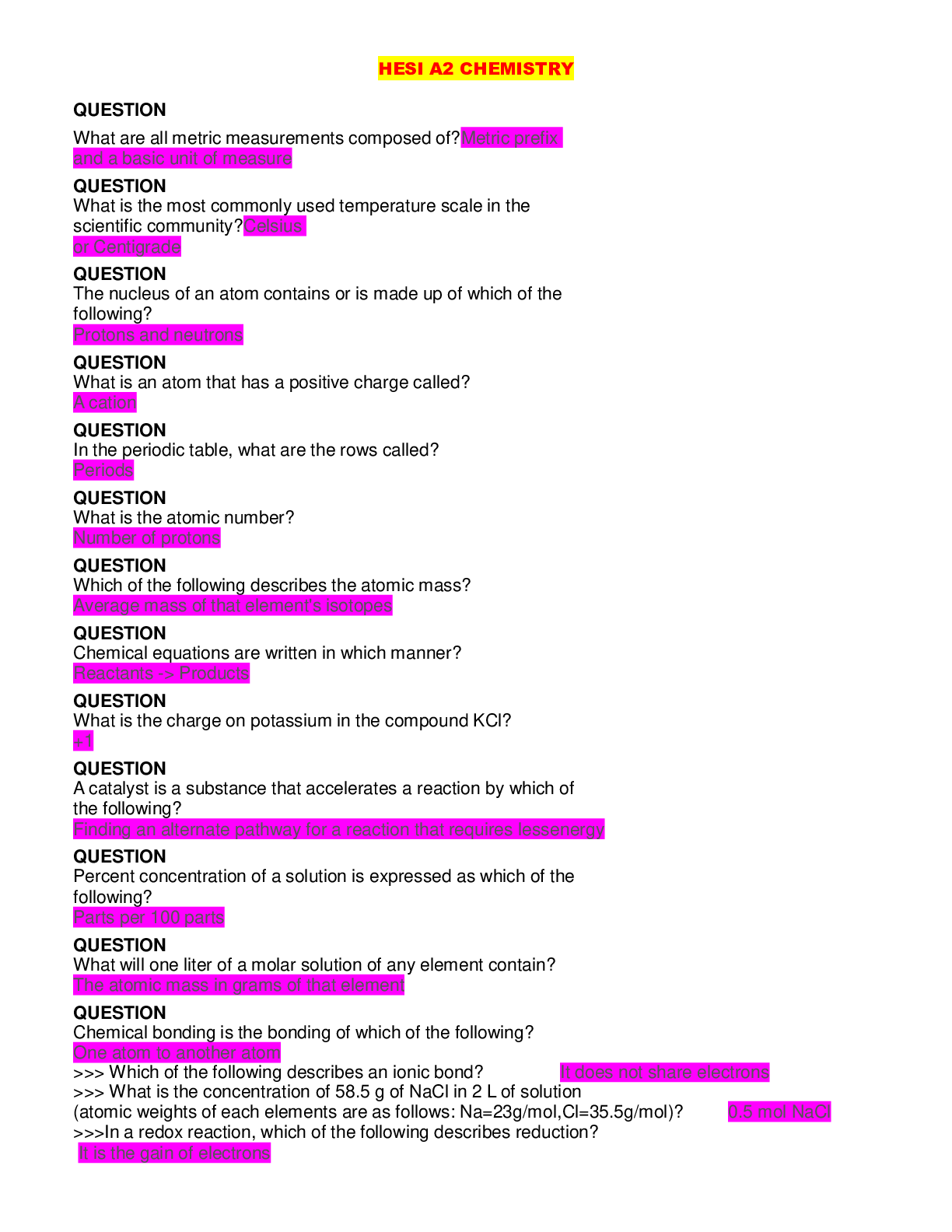
Reviews( 0 )
Document information
Connected school, study & course
About the document
Uploaded On
Mar 16, 2021
Number of pages
66
Written in
Additional information
This document has been written for:
Uploaded
Mar 16, 2021
Downloads
0
Views
43


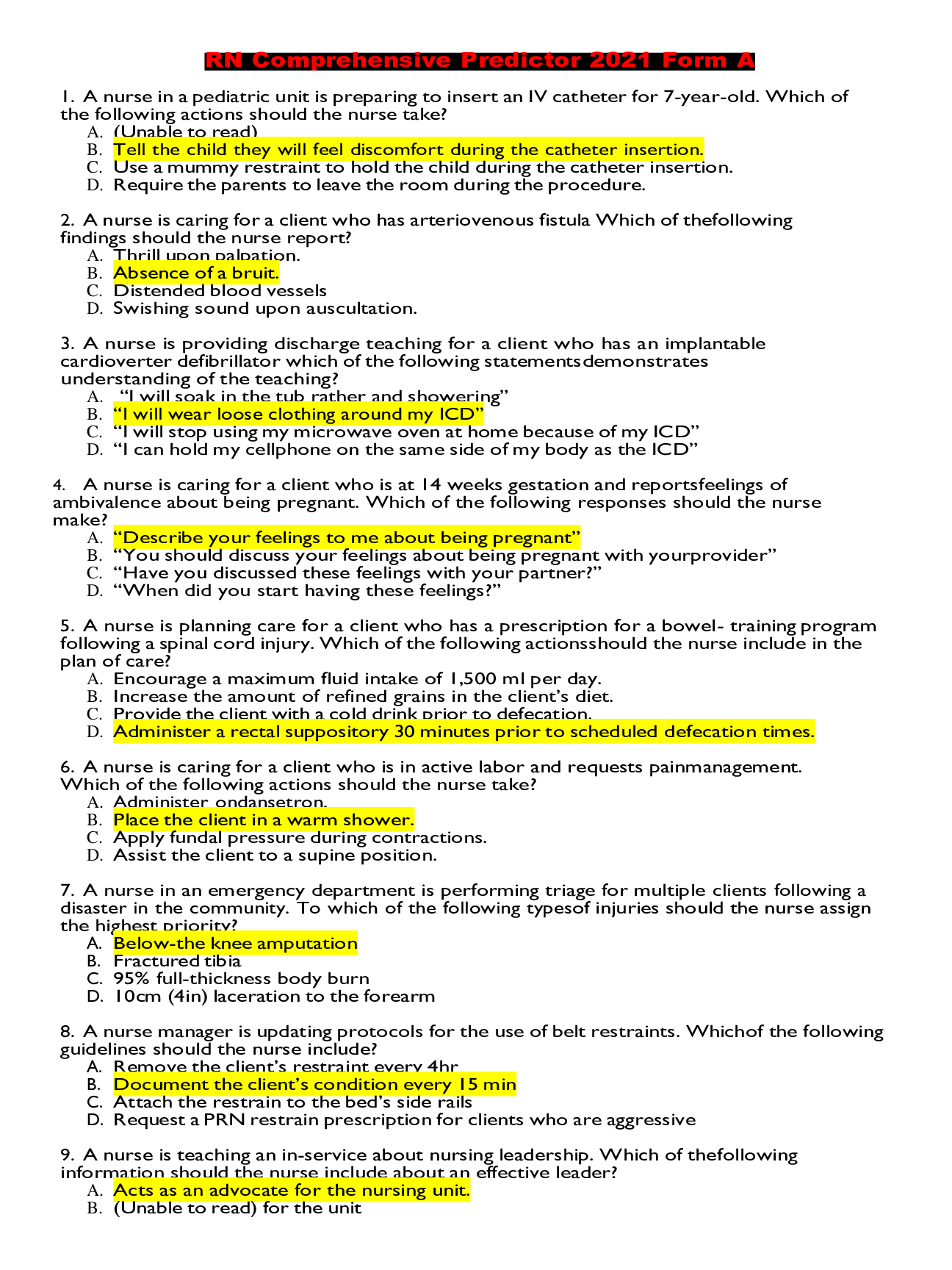
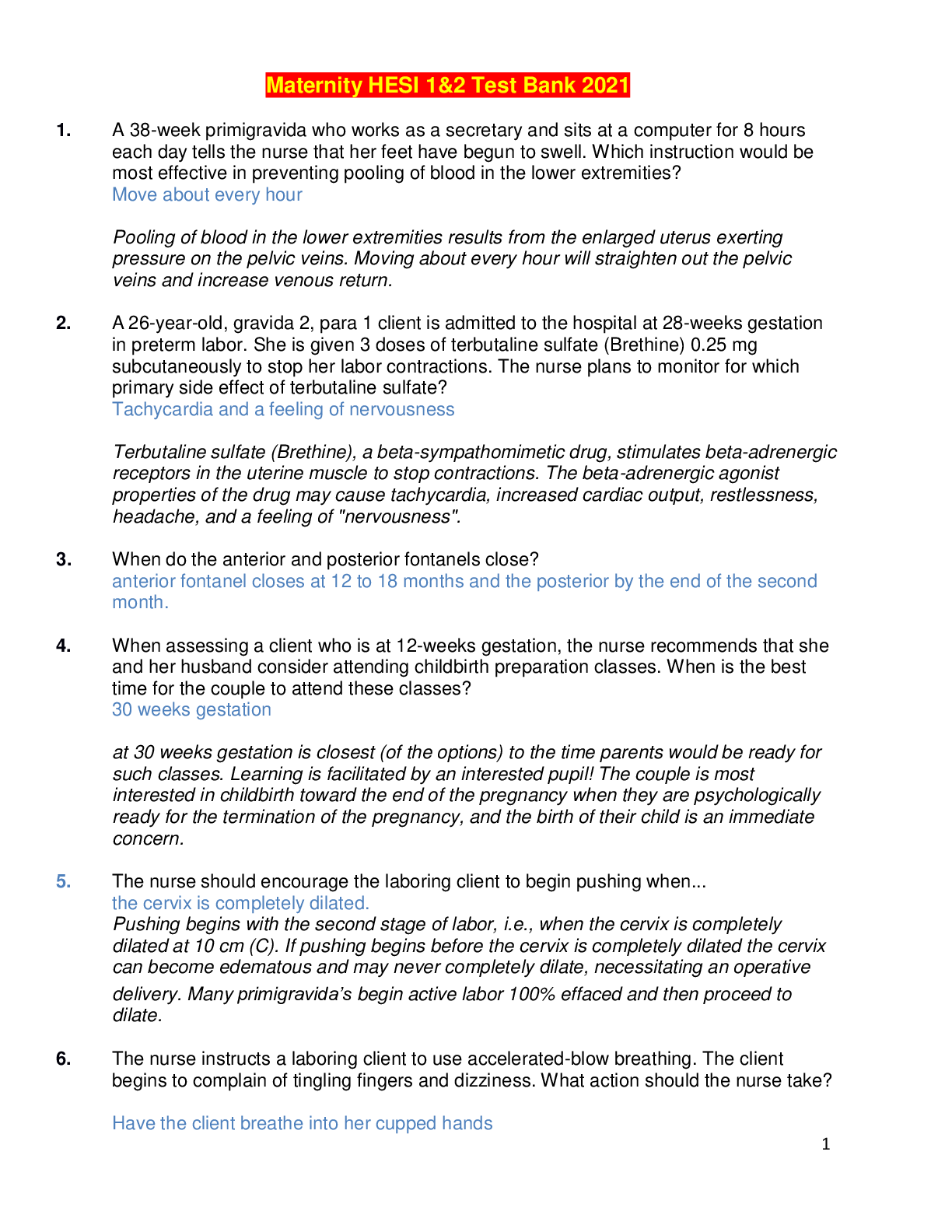
.png)


